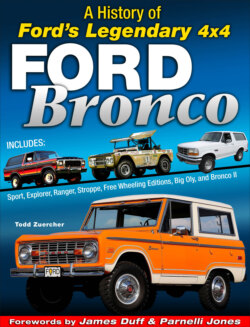Читать книгу Ford Bronco: A History of Ford's Legendary 4x4 - Todd Zuercher - Страница 11
На сайте Литреса книга снята с продажи.
IN THE BEGINNING
ОглавлениеChapter ONE
“We think of the Bronco as neither a conventional car nor a truck, but as a vehicle which combines the best of both worlds. It can serve as a family sedan, a sports roadster, a snow plow, or as a farm or civil defense vehicle. It has been designed to go nearly anywhere and do nearly anything.”
The Bronco was not Ford Motor Company’s first foray into the world of sport utility vehicles (SUVs) that bridged the gap between cars and trucks. In fact, the seeds were planted almost 25 years earlier when Ford became one of the producers of the ubiquitous World War II Army Jeep. When Bantam Motor Company and Willys Motors could not keep up with Jeep production in the fall of 1941, the vast resources of Ford Motor Company were brought to bear in helping produce vehicles for the war effort. Ford produced almost 278,000 quarter-ton 4x4s, known as GPWs, in nearly four years of production, earning the love and respect of veterans (GIs) throughout the various theaters of the war.
When those GIs returned from the war, they married, started families, and bought surplus Jeeps. The little trucks, in turn, birthed a new form of recreation in the United States in the years following the war, allowing families to explore the country’s rugged backcountry. Legions of young men and women took their first turn behind the wheel in Jeeps, and the small utility vehicles served faithfully as snow plows, farm runabouts, ranch hands, maintenance vehicles, and errand runners. The Jeep line received a few upgrades in the 1950s, but the advent of the interstate highway system and higher speeds meant that the surplus war trucks and their younger brethren started to fall behind.
In 1960, the vehicle segment that is now known as the SUV market consisted of about 11,000 vehicle sales annually, with the majority belonging to the Jeep brand. In 1961, the International Scout was introduced and the market immediately expanded to 32,000 vehicles per year. In the year before the Bronco was introduced, the market had stabilized at about 40,000 units with Jeep and International capturing 85 percent of those sales and foreign-made units, such as the Toyota Landcruiser and Nissan Patrol, comprising the rest. Ford estimated there were about 200,000 SUVs on the road at the time of the Bronco’s introduction. This increased growth in the utility vehicle market was not lost on Ford. In the early 1960s, the company embarked on a detailed marketing survey to determine what enthusiasts might be looking for in a new utility vehicle. Ford interviewed hundreds of potential customers about what they liked and disliked most about their current utility vehicles, without revealing they were doing the research under the auspices of the Ford Motor Company.
This pristine 1966 U13 Roadster is believed to have been built during the first week’s production in August 1965. A dealership vehicle for the first 17 years of its life, it was not titled until 1983. After some time on a wheat farm in North Dakota, Donald and Drew Peroni purchased it in 2000 and performed a frame-off restoration. The Bronco has traveled about 12,000 miles in its life. (Photo Courtesy Freeze Frame Image LLC, Al Rogers)
At the press introduction of the Bronco, Ford Division’s general manager Donald N. Frey noted that in conversations with customers, many were intensely loyal to their vehicles and didn’t want to change a thing but upon further questioning revealed some things that they did want. The young warriors who had driven the Jeeps in World War II were now in their 40s and 50s and wanted a tough vehicle that could do everything a Jeep could but with more comfort and more interior room. They wanted a vehicle that could cruise at highway speeds with more ease than the old Jeeps and they wanted cabs that were better insulated and better sealed against the rain. They wanted nicer paint jobs, more rust protection, and smoother-riding suspension systems. And although they wanted improvements over the existing offerings in the utility four-wheel-drive market, they didn’t want “too many fancy frills.” There was room for new ideas in this market segment, and luckily, the Bronco was poised to step in.
